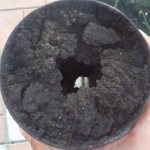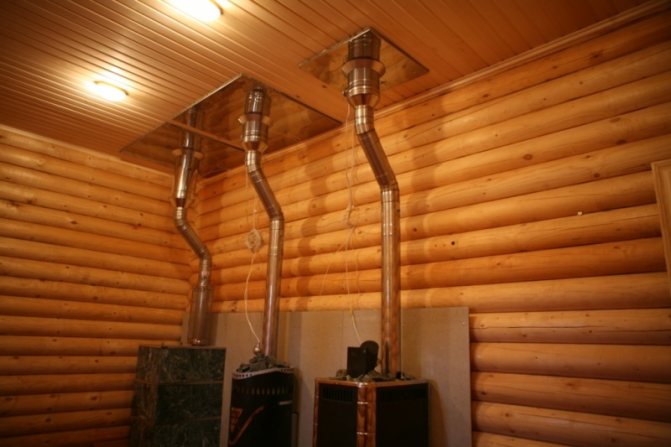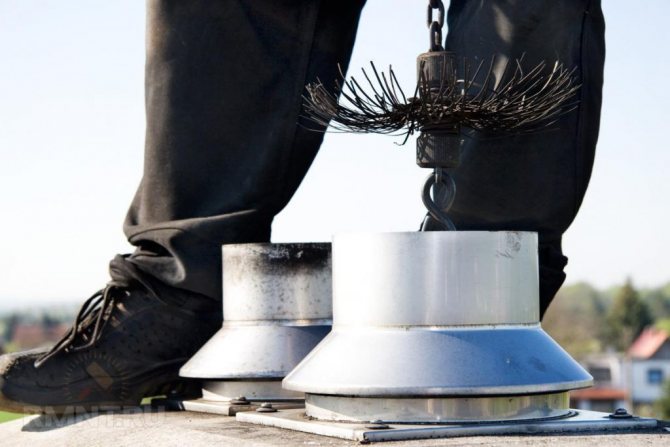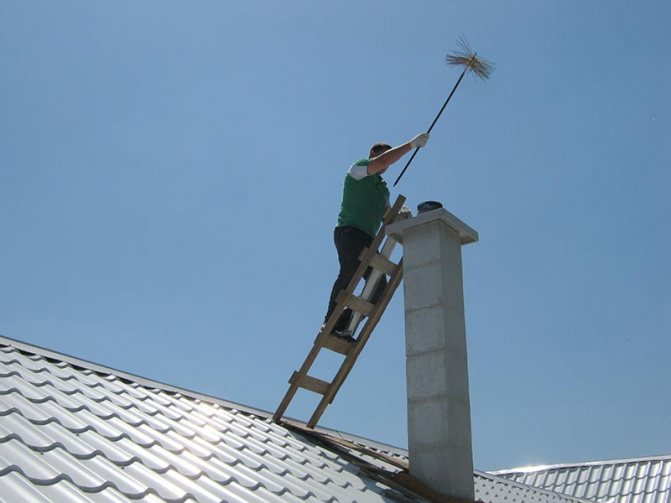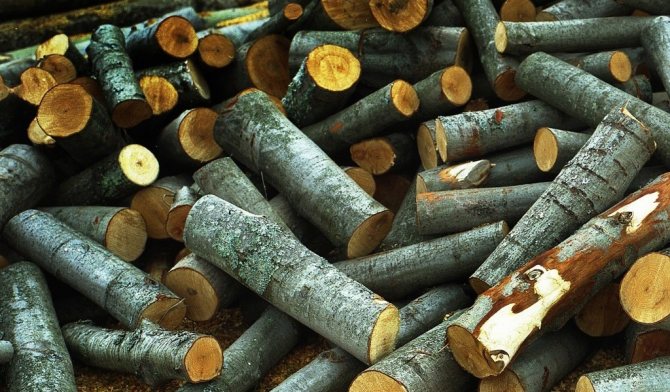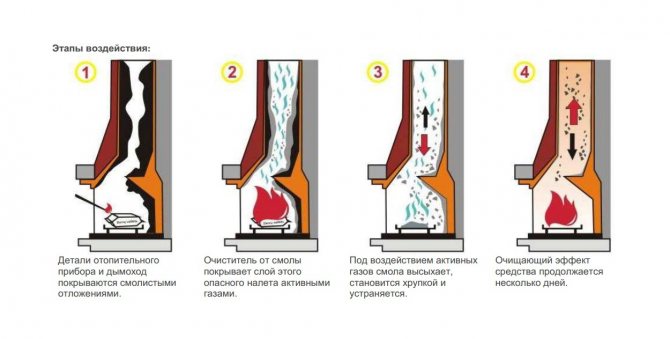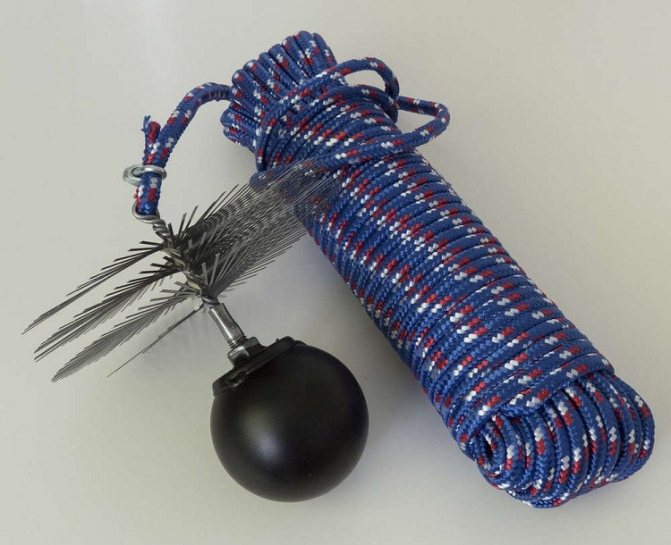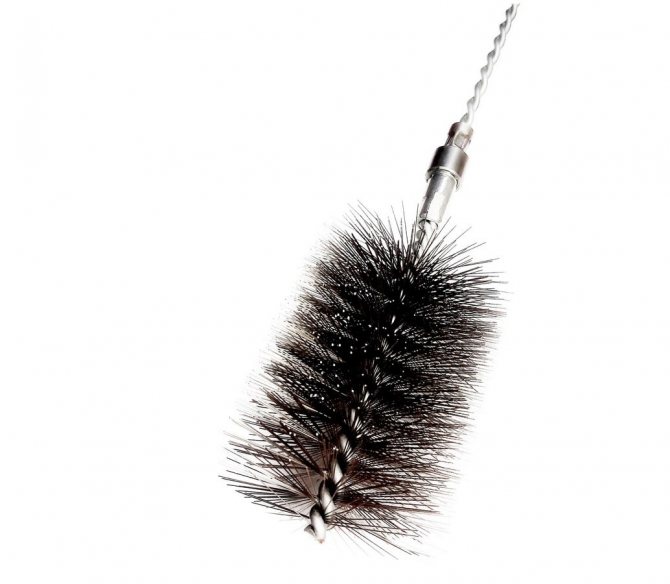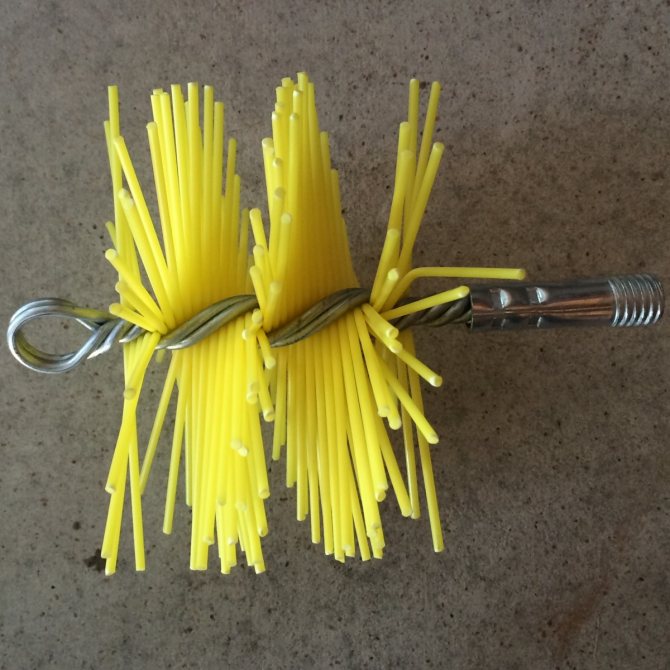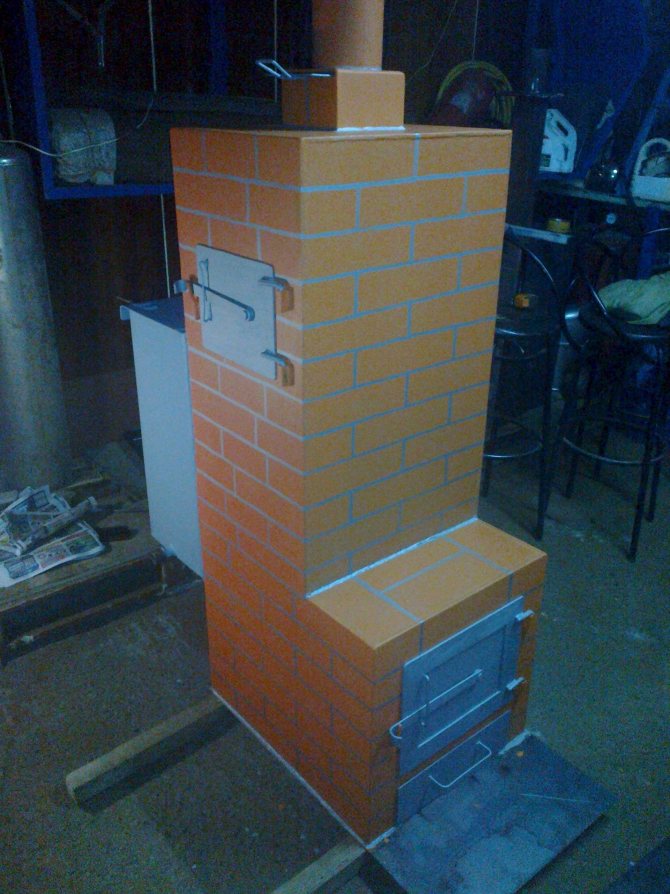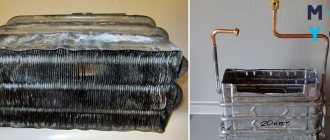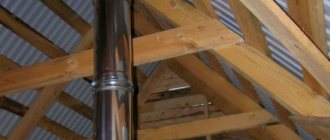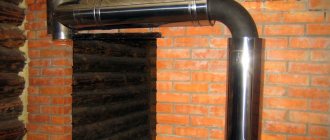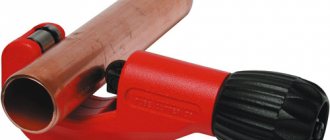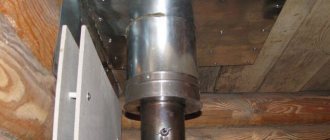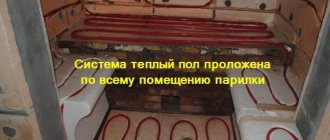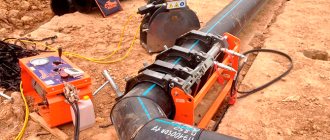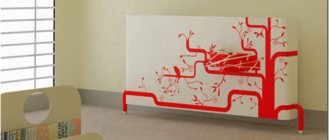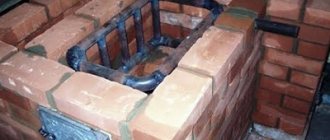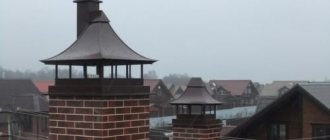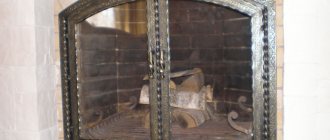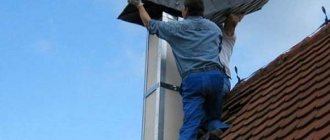Heating a sauna stove with wood or coal gives a lot of heat, but a side effect of fuel combustion will always be the formation of soot and soot. They quickly form a sediment on the inner surface of the chimney pipe, reducing its clearance. Leaving it in this form is not only impractical, but also dangerous.
In addition to poor draft in the chimney, a large amount of ash is fraught with fire and fire. To avoid a dangerous situation, it is necessary to regularly inspect the chimney pipe, and, as soot accumulates, clean it using available methods.
Reasons for clogging the chimney in the bath
Pipe clogging can occur for various reasons. The accumulation of soot described above on the inner surface of the chimney pipe is an inevitable process, because the combustion products of the fuel in the form of particles settle on a metal or brick surface by themselves.
Condensation from water vapor, which is formed from moisture in wood fibers, accelerates the formation of plaque.
When using firewood from coniferous trees, which give an acid sludge, the formation of plaque on the pipe is even faster.
Other causes of chimney clogging are a mechanical obstruction that closes the chimney lumen. It can be a nest or a bird accidentally caught in the chimney, a tree branch, a piece of roofing material and other objects.
It is important! Mechanical clogging is a dangerous phenomenon: it not only reduces, but completely eliminates the draft, and it becomes dangerous to use the firebox. Waste gases and combustion products will flow back into the room and poison the air.
Use of chemicals
Chemicals used to clean the chimney in the bath are more likely to prevent excessive accumulation of soot than to actually remove it. Such substances cannot completely remove plaque without the use of mechanical cleaning methods.
In addition, most of them have a pungent, unpleasant odor that will disappear for several days. However, it is worth noting that, as a last resort, you can take on arms such means as "Log-chimney sweep" or "Kominichek".
Chemicals used to clean the chimney in the bath are more likely to prevent excessive accumulation of soot than to actually remove it. Such substances cannot completely remove plaque without the use of mechanical cleaning methods.
Chimney cleaning methods
There are various ways to clean the pipe. Which one is suitable depends on the characteristics of the stove heating in the bath, the material and the length of the chimney.
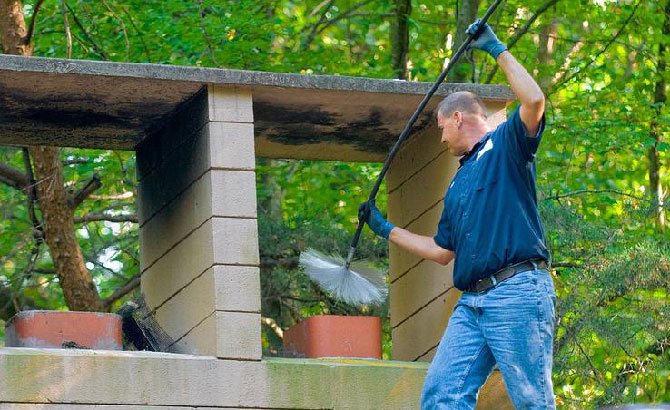
Mechanical
The easiest way to clean the chimney is to mechanically remove blockages and soot deposits. acting on the principle of a brush.
First, it is necessary to assess the degree of clogging and narrowing of the chimney lumen. You can use a flashlight, flexible cable with a video camera.
If there is a physical obstacle in the pipe - a nest, a remnant of slate - it is necessary to push it through with a long stick or pole
We recommend that you familiarize yourself with: Do-it-yourself rules for installing a chimney through a wall
Usually, to clean the chimney with the help of human physical strength, special brushes are used, which are sold in stores. They scrape and sweep away the resulting soot layer. Thanks to the flexible handle, this brush can be used to thoroughly clean the pipe.
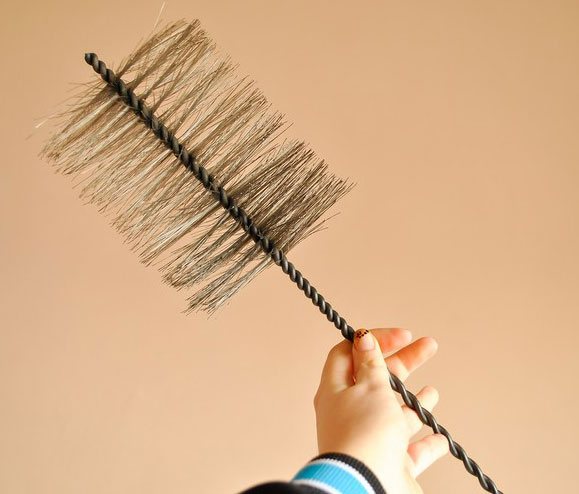

Important! To clean the metal chimney pipe, it is forbidden to use brushes and brushes on a metal base, because they can damage the pipe, leaving scratches on its surface. Only use a nylon or plastic resin brush.You can buy it in the store or make it yourself.
Another option for mechanical cleaning of the chimney is to hang the brush on a special cable with a load. The weighting creates the necessary tension, so that the brush or ruff comes into contact with the surface of the chimney pipe and scrapes off the soot.
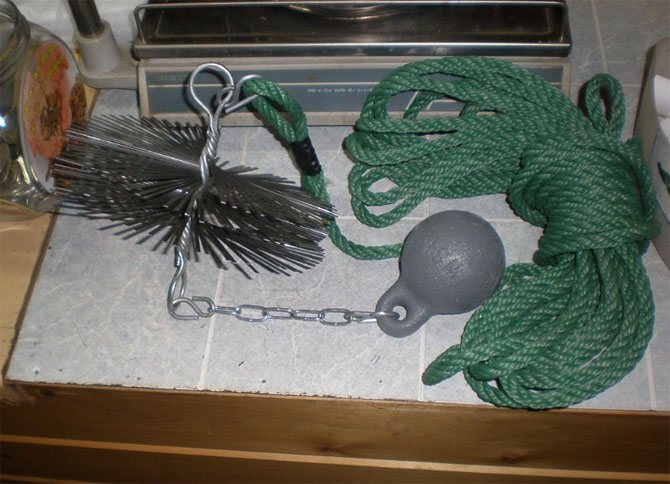

Some people use a simple watering hose to clean the chimney, which is inserted into the pipe and made translational movements. At the same time, the soot is knocked off the surface of the walls and falls into the furnace, from where it is then collected and disposed of.
Mechanical cleaning methods include the use of special equipment operating on the principle of a vacuum cleaner. For example, these can be special installations that are inserted into the outer opening of the chimney on the roof.
The appliance creates a strong draft that sucks out the soot like a vacuum cleaner. The disadvantage of this method is that there is no container or bag for collecting the soot, and the soot and soot to be removed are simply blown out of the pipe into the air. At the same time, the roof and the adjacent territory are polluted. Although this method is quite effective, it usually causes strong resentment among neighbors.
Another similar method is the "Tornado" set, which consists of six-meter interconnected handles and a nylon brush. The handles are connected in series so that the resulting structure matches the length of the chimney. A brush is attached to its outer end, and the other end is attached to a drill.
The fast rotation of the brush due to the torque of the drill allows you to effectively clean the chimney pipe. To protect against soot, a special film is attached to the firebox, which is sold with the kit.
Chemical
Chemically active substances can be used to remove soot from the chimney, provided that there are no mechanical blockages in the chimney, and the thickness of the plaque does not exceed 2 cm.
We recommend that you familiarize yourself with: How to make a spark arrester with your own hands for a chimney?
Means in the form of powders, briquettes, fluids for chemical cleaning of the chimney are burned together with fuel. During combustion, they release gases that chemically react with the soot on the surface of the pipe, which crumbles downward.
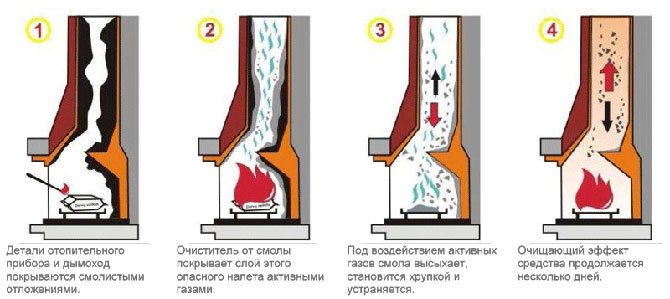

Chemicals, if used correctly, are safe for humans and furnace equipment.
The most famous among them:
- PKH - anti-carbonaceous chemical composition;
- "Kominichek";
- "Log chimney sweep";
- "Smoke";
- Vortex;
- "Sazhinet".
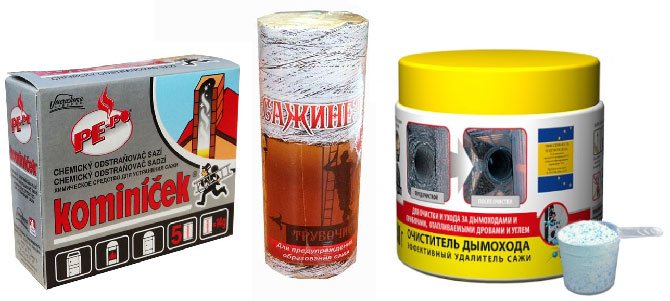

Important! It is optimal to use these reagents as a preventive measure, burning them together with the fuel every few months, preventing the formation of a thick soot deposit. In this case, there is no need to mechanically clean the chimney.
Folk ways
Traditional methods of chimney cleaning are based on the chemical and thermodynamic properties of various materials.
One of the simplest, most affordable and popular folk methods is burning potato peelings in a furnace. In the process of burning, they release starch, which, together with the smoke, settles on the surface of the pipe and enters into a chemical reaction with soot. After a few days, it crumbles completely, leaving the chimney clean.
Another method is burning aspen logs, which, when burning, create an extremely high temperature, due to which the soot itself burns out.
Attention! Using aspen logs is an effective but unsafe way. It cannot be used for metal round chimneys. Since the temperature during firewood burning exceeds 1000 degrees, this can lead to the destruction of the chimney channel and fire the roof. It is advisable to install a spark arrestor to avoid fire.
The last method that can be attributed to the folk is the burning of simple table salt in a firebox.The salt makes the soot layer on the pipe surface soft, but does not completely remove it. This is rather a combined method based on chemical and mechanical cleaning of the pipe (after burning the salt, you need to wait until the pipe cools down and clean the chimney with a brush).
Blockage prevention
If you adhere to the rules for operating the stove, then you will have to clean the chimneys much less often.
| Do's and Don'ts | For what reason |
| First you need to exclude the burning of coniferous wood. | When they burn, they emit a large amount of resins that settle on the walls of the chimney, although burning conifers does not pose any danger to human health. |
| Also, do not throw rubbish, synthetic rags, or plastic bottles into the oven. | This leads not only to the release of harmful substances, but also impairs the operation of the oven. Therefore, with the systematic use of these materials, it will be necessary to shift the furnace again. |
| The absence of condensation is also an important point. | This can be achieved by insulating the chimney in advance. |
In addition, to prevent blockages, you need to build a certain plan of mandatory measures with a certain frequency of their implementation. We offer the following option:
- Checking the oven and equipment for it.
- Chimney inspection.
- Visual inspection of pipes.
Of course, every time before going to the bathhouse, you will not check all the pipes in the oven. But you should be very careful with the chimney, which can get foreign objects. Therefore, do not leave the oven unattended and check the oven equipment regularly.
Now there is practically no such profession as a chimney sweep. Therefore, many have to do their own chimney cleaning. And even despite the fact that this process is hard physical labor, the technology itself is quite simple, and regular prevention of chimney operation will reduce the frequency of such events.
How to make a DIY cleaning brush
It is not difficult to make a brush for mechanical pipe cleaning with your own hands. Many craftsmen use improvised means and even household waste for this. The easiest and most popular way to make a brush is from unnecessary plastic bottles or an old broom with synthetic fibers.
We recommend that you familiarize yourself with: How to install pipes for heating systems
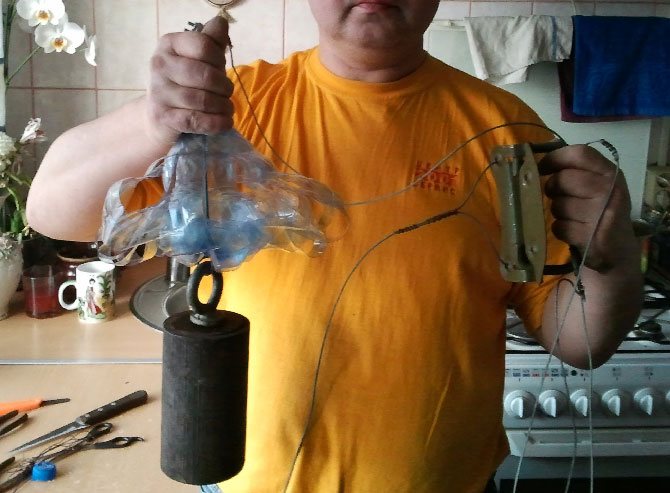

If a bottle (1-3 pcs) is used, you need to cut it in half, then make thin rods with scissors. Disassemble the old broom by detaching the base from the nylon fibers.
To make a brush, you will also need a cable, special clamps for fastening, two "ears", a fixing pin and washers.
- The broom pile or cut bottle must be folded back to form a flat round base.
- The hairpin must be connected to the "ear" and washer, threaded through the hole in the broom and screw the second washer on the other side.
- Then the second "ear" is connected, which must be screwed very tightly so that the broom pile spreads out almost horizontally in the form of a circle.
- With the help of a clamp, the resulting brush is attached to the cable.
Important! The diameter of the brush must match the diameter of the flue pipe. If the brush is smaller, then its nap will not reach the walls, and if it is larger, then the nylon bristles will simply slide along the walls, and not scrape off the soot.
Metal chimneys, their operation and care
Metal chimneys can be single-walled or insulated, that is, a sandwich. The former are considered cheap, but the owners note the short service life of such chimney systems, the presence of condensation, the rapid appearance of plaque inside the pipes. Modern single-circuit chimneys can have an enamel coating on the inner walls, which protects against excessively rapid accumulation of soot.
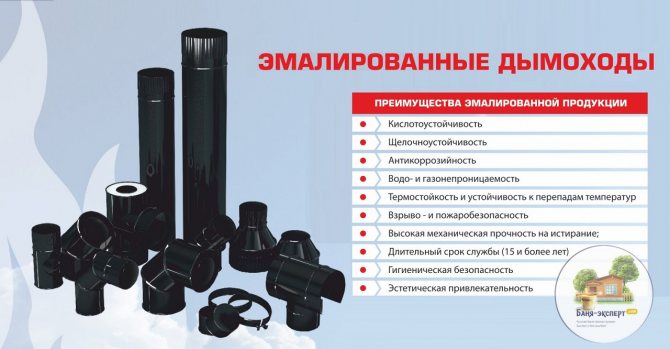

AGNI enameled chimneys
Insulated double-walled chimneys, provided that they are correctly installed, can solve the problem of condensation, and since the inner walls are as smooth as possible, soot accumulates more slowly than in brick chimneys. But this does not relieve the owners of metal chimneys from the need for periodic cleaning.
Heating the stove with aspen wood
Our ancestors also knew how to clean the chimney in the bathhouse with aspen wood. To do this, it is enough to intensively heat the stove with them. However, we must not forget that this method is quite dangerous.
The fact is that during the kindling of the aspen stove, a very high temperature is injected inside the chimney, as a result of which the soot ignites and escapes from the chimney, then settling in white flakes in the yard.
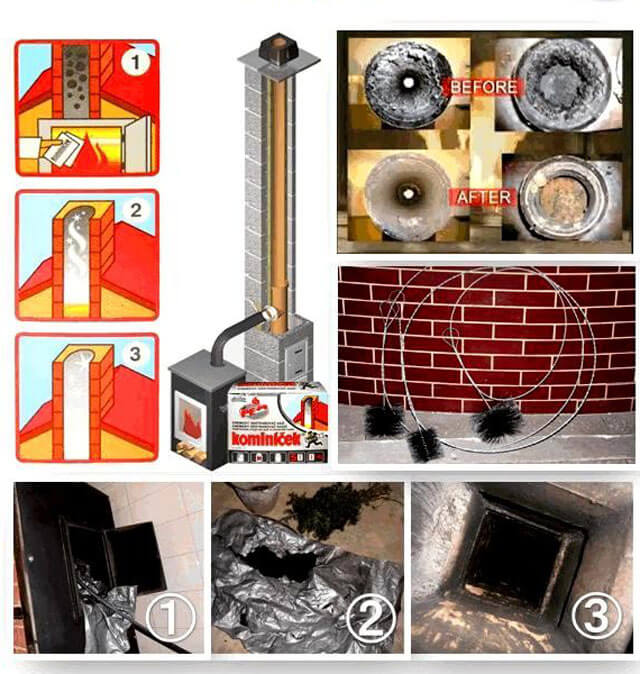

To get this result, leave all the dampers and doors open in the oven, creating good draft. Firewood is constantly being thrown into the firebox, so that the fire burns intensely and a buzz is heard in the chimney. In this case, the temperature in the chimney reaches 1100 ºС, at which the soot burns. However, the cleaning is very efficient.

